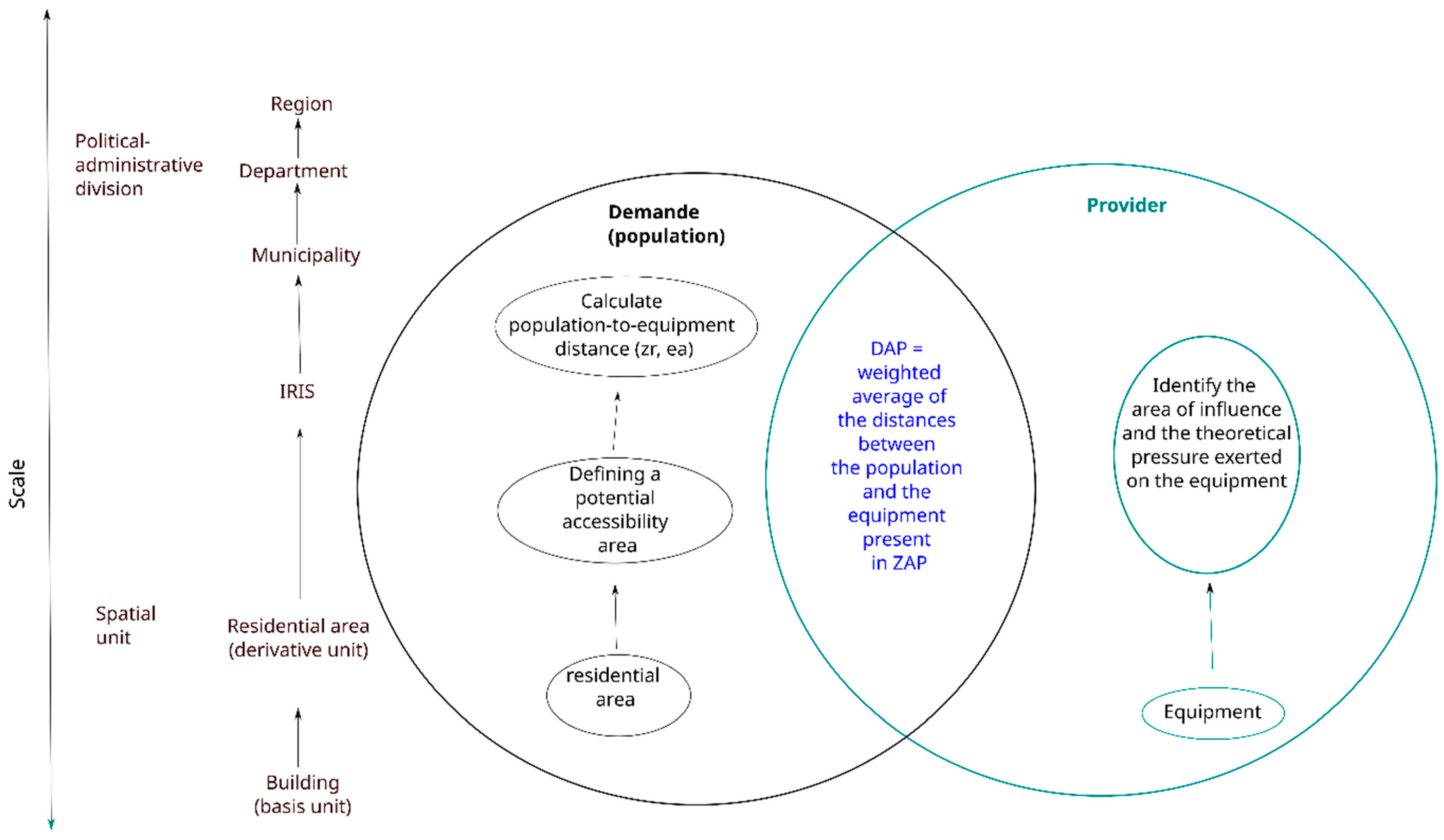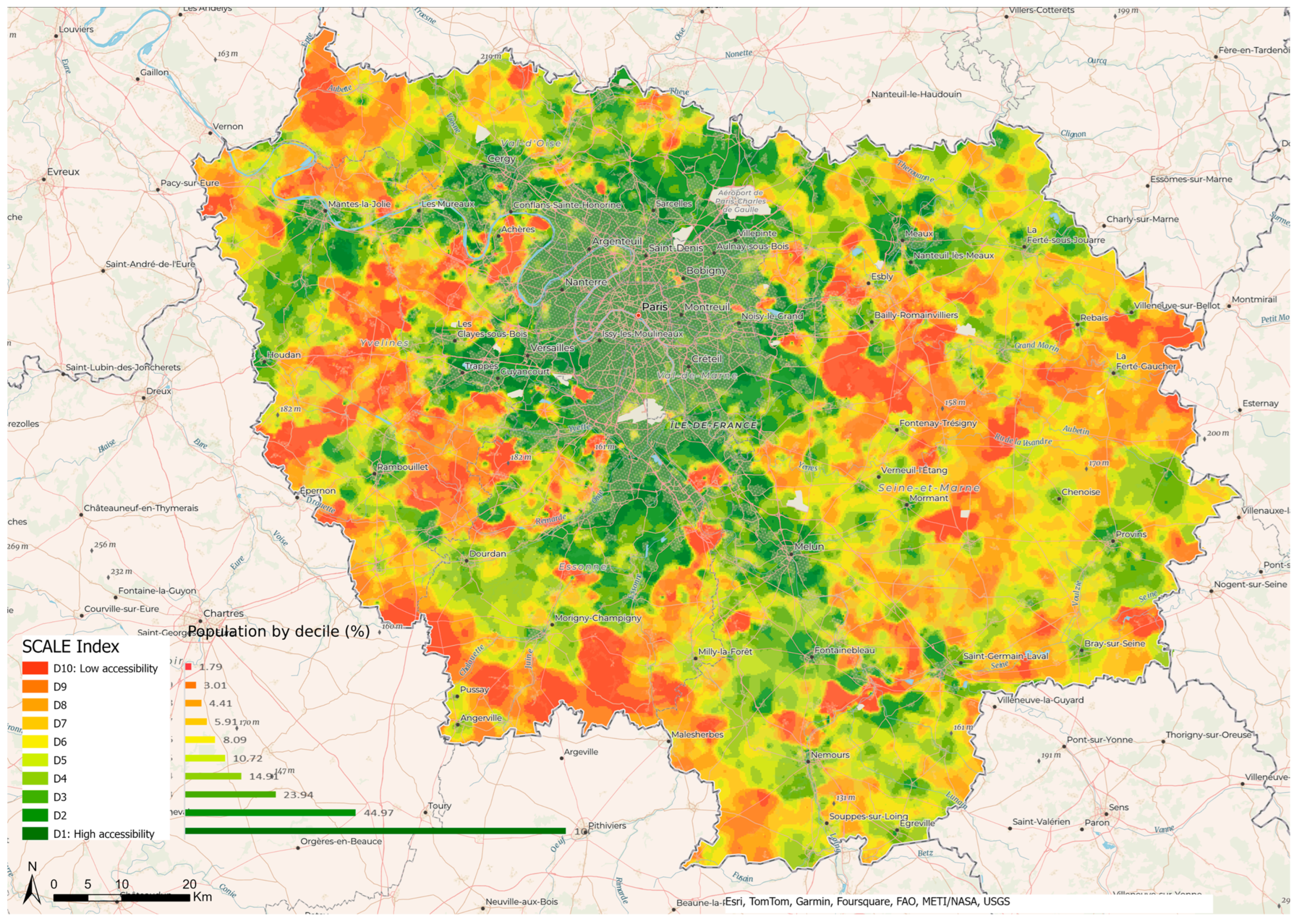Spatial Accessibility to Primary Care in Metropolitan France: Results Using the SCALE Spatial Accessibility Index for All Regions
Abstract
1. Introduction
2. Materials and Methods
2.1. Construction of SCALE
2.2. SCALE Index Using Road Network
2.3. Modification of Geographical Unit
3. Results
3.1. Comparison between Localized Potential Accessibility 2018 and the Potential Accessibility Distance to General Practitioners
3.2. SCALE INDEX at Different Geographical Levels
4. Discussion
5. Conclusions
Supplementary Materials
Author Contributions
Funding
Institutional Review Board Statement
Informed Consent Statement
Data Availability Statement
Acknowledgments
Conflicts of Interest
Abbreviations
References
- Aday, L.A.; Andersen, R. A framework for the study of access to medical care. Health Serv. Res. 1974, 9, 208–220. [Google Scholar]
- Guagliardo, M.F. Spatial accessibility of primary care: Concepts, methods and challenges. Int. J. Health Geogr. 2004, 3, 3. [Google Scholar] [CrossRef] [PubMed]
- Delamater, P.L.; Shortridge, A.M.; Kilcoyne, R.C. Using floating catchment area (FCA) metrics to predict health care utilization patterns. BMC Health Serv. Res. 2019, 19, 144. [Google Scholar] [CrossRef] [PubMed]
- Piovani, D.; Arcaute, E.; Uchoa, G.; Wilson, A.; Batty, M. Measuring Accessibility using Gravity and Radiation Models [Internet]. arXiv 2018, arXiv:1802.06421. Available online: http://arxiv.org/abs/1802.06421 (accessed on 12 February 2024).
- Yang, R.; Liu, Y.; Liu, Y.; Liu, H.; Gan, W. Comprehensive Public Transport Service Accessibility Index—A New Approach Based on Degree Centrality and Gravity Model. Sustainability 2019, 11, 5634. [Google Scholar] [CrossRef]
- Kapatsila, B.; Palacios, M.S.; Grisé, E.; El-Geneidy, A. Resolving the accessibility dilemma: Comparing cumulative and gravity-based measures of accessibility in eight Canadian cities. J. Transp. Geogr. 2023, 107, 103530. [Google Scholar] [CrossRef]
- Delamater, P.L. Spatial accessibility in suboptimally configured health care systems: A modified two-step floating catchment area (M2SFCA) metric. Health Place 2013, 24, 30–43. [Google Scholar] [CrossRef]
- Langford, M.; Higgs, G.; Fry, R. Multi-modal two-step floating catchment area analysis of primary health care accessibility. Health Place 2016, 38, 70–81. [Google Scholar] [CrossRef]
- Luo, W.; Whippo, T. Variable catchment sizes for the two-step floating catchment area (2SFCA) method. Health Place 2012, 18, 789–795. [Google Scholar] [CrossRef]
- Mao, L.; Nekorchuk, D. Measuring spatial accessibility to healthcare for populations with multiple transportation modes. Health Place 2013, 24, 115–122. [Google Scholar] [CrossRef]
- McGrail, M.R.; Humphreys, J.S. Measuring spatial accessibility to primary care in rural areas: Improving the effectiveness of the two-step floating catchment area method. Appl. Geogr. 2009, 29, 533–541. [Google Scholar] [CrossRef]
- Dai, D.; Wang, F. Geographic Disparities in Accessibility to Food Stores in Southwest Mississippi. Environ. Plan. B Plan. Des. 2011, 38, 659–677. [Google Scholar] [CrossRef]
- Wan, N.; Zou, B.; Sternberg, T. A 3-step floating catchment area method for analyzing spatial access to health services. Int. J. Geogr. Inf. Sci. 2012, 26, 1073–1089. [Google Scholar] [CrossRef]
- McGrail, M.R.; Humphreys, J.S. The index of rural access: An innovative integrated approach for measuring primary care access. BMC Health Serv. Res. 2009, 9, 124. [Google Scholar] [CrossRef]
- McGrail, M.R.; Humphreys, J.S. Measuring spatial accessibility to primary health care services: Utilising dynamic catchment sizes. Appl. Geogr. 2014, 54, 182–188. [Google Scholar] [CrossRef]
- Jamtsho, S.; Corner, R.; Dewan, A. Spatio-Temporal Analysis of Spatial Accessibility to Primary Health Care in Bhutan. ISPRS Int. J. Geo-Inf. 2015, 4, 1584–1604. [Google Scholar] [CrossRef]
- Luo, J. Integrating the Huff Model and Floating Catchment Area Methods to Analyze Spatial Access to Healthcare Services. Trans. GIS 2014, 18, 436–448. [Google Scholar] [CrossRef]
- Huff, D.L. A Probabilistic Analysis of Shopping Center Trade Areas. Land Econ. 1963, 39, 81–90. [Google Scholar] [CrossRef]
- Luo, W.; Wang, F. Measures of Spatial Accessibility to Healthcare in a GIS Environment: Synthesis and a Case Study in Chicago Region. Environ. Plan. B Plan. Des. 2003, 30, 865–884. [Google Scholar] [CrossRef]
- Luo, W.; Qi, Y. An enhanced two-step floating catchment area (E2SFCA) method for measuring spatial accessibility to primary care physicians. Health Place 2009, 15, 1100–1107. [Google Scholar] [CrossRef]
- Barlet, M.; Coldefy, M.; Collin, C.; Lucas-Gabrielli, V. L’Accessibilité potentielle localisée (APL): Une nouvelle mesure de l’accessibilité aux médecins généralistes libéraux. Études et Résult. 2012, 795, 1–8. [Google Scholar]
- Parvin, F.; Ali, S.A.; Hashmi, S.N.I.; Khatoon, A. Accessibility and site suitability for healthcare services using GIS-based hybrid decision-making approach: A study in Murshidabad, India. Spat. Inf. Res. 2021, 29, 1–18. [Google Scholar] [CrossRef]
- Rauch, S.; Stangl, S.; Haas, T.; Rauh, J.; Heuschmann, P.U. Spatial inequalities in preventive breast cancer care: A comparison of different accessibility approaches for prevention facilities in Bavaria, Germany. J. Transp. Health 2023, 29, 101567. [Google Scholar] [CrossRef]
- Launay, L.; Guillot, F.; Gaillard, D.; Medjkane, M.; Saint-Gérand, T.; Launoy, G.; Dejardin, O. Methodology for building a geographical accessibility health index throughout metropolitan France. PLoS ONE 2019, 14, e0221417. [Google Scholar] [CrossRef]
- Pouchucq, C.; Menahem, B.; Le Roux, Y.; Bouvier, V.; Gardy, J.; Meunier, H.; Thomas, F.; Launoy, G.; Dejardin, O.; Alves, A. Are Geographical Health Accessibility and Socioeconomic Deprivation Associated with Outcomes Following Bariatric Surgery? A Retrospective Study in a High-Volume Referral Bariatric Surgical Center. Obes. Surg. 2022, 32, 1486–1497. [Google Scholar] [CrossRef]
- Thomas, F.; Bouvier, A.M.; Cariou, M.; Bouvier, V.; Jooste, V.; Pouchucq, C.; Gardy, J.; Queneherve, L.; Launoy, G.; Alves, A.; et al. Influence of non-clinical factors on restorative rectal cancer surgery: An analysis of four specialized population-based digestive cancer registries in France. Dig. Liver Dis. Off. J. Ital. Soc. Gastroenterol. Ital. Assoc. Study Liver 2022, 54, 258–267. [Google Scholar] [CrossRef]
- Kang, J.Y.; Michels, A.; Lyu, F.; Wang, S.; Agbodo, N.; Freeman, V.L.; Wang, S. Rapidly measuring spatial accessibility of COVID-19 healthcare resources: A case study of Illinois, U.S.A. Int. J. Health Geogr. 2020, 19, 36. [Google Scholar] [CrossRef] [PubMed]
- Gao, F.; Kihal, W.; Le Meur, N.; Souris, M.; Deguen, S. Assessment of the spatial accessibility to health professionals at French census block level. Int. J. Equity Health 2016, 15, 125. [Google Scholar] [CrossRef] [PubMed]
- Bauer, J.; Müller, R.; Brüggmann, D.; Groneberg, D.A. Spatial Accessibility of Primary Care in England: A Cross-Sectional Study Using a Floating Catchment Area Method. Health Serv. Res. 2018, 53, 1957–1978. [Google Scholar] [CrossRef] [PubMed]
- Fransen, K.; Neutens, T.; De Maeyer, P.; Deruyter, G. A commuter-based two-step floating catchment area method for measuring spatial accessibility of daycare centers. Health Place 2015, 32, 65–73. [Google Scholar] [CrossRef] [PubMed]
- Green, M.A.; Daras, K.; Davies, A.; Barr, B.; Singleton, A. Developing an openly accessible multi-dimensional small area index of ‘Access to Healthy Assets and Hazards’ for Great Britain, 2016. Health Place 2018, 54, 11–19. [Google Scholar] [CrossRef] [PubMed]





| Aggregation Criteria for Each Spatial Unit | ||||||||
|---|---|---|---|---|---|---|---|---|
| IRIS | Commune | |||||||
| Min | Max | Mean | Weighted Mean | Min | Max | Mean | Weighted Mean | |
| Min | −21.9 | −20.75 | −20.75 | −21.18 | −21.9 | −15.74 | −17.18 | −20.07 |
| Mean | −5.18 | −1.75 | −3.03 | −3.01 | −3.11 | 1.15 | −0.45 | −0.56 |
| Std | 4.96 | 6.14 | 5.73 | 5.82 | 3.7 | 3.69 | 3.67 | 4 |
| P25 | −8.9 | −5.47 | −6.86 | −6.98 | −5.09 | −1.04 | −2.56 | −2.85 |
| P50 | −4.15 | −0.31 | −1.75 | −1.81 | −2.58 | 1.1 | −0.33 | −0.31 |
| P75 | −1.31 | 2.43 | 0.97 | 1.07 | −0.57 | 3.25 | 1.73 | 1.84 |
| Max | 18.1 | 25.5 | 23.3 | 25 | 18.06 | 25.45 | 23.29 | 24.96 |
| Type | Density | Distance | 2SFCA | APL | SCALe Index |
|---|---|---|---|---|---|
| Density | Density | Distance | |||
| Geographic scale | Depends on application | Municipality n ≈ 36,000 or IRIS n ≈ 50,000 | Municipality n ≈ 36,000 | Residential area n ≈ 2.7 M, IRIS n ≈ 50,000, municipality n ≈ 36,000 | |
| Availability of caregivers | No | No | Number of professionals | Full-time equivalent number of caregivers | Pressure rate estimated by Voronoï mosaic |
| Strength |
|
|
|
|
|
| Weakness |
|
|
|
|
|
Disclaimer/Publisher’s Note: The statements, opinions and data contained in all publications are solely those of the individual author(s) and contributor(s) and not of MDPI and/or the editor(s). MDPI and/or the editor(s) disclaim responsibility for any injury to people or property resulting from any ideas, methods, instructions or products referred to in the content. |
© 2024 by the authors. Licensee MDPI, Basel, Switzerland. This article is an open access article distributed under the terms and conditions of the Creative Commons Attribution (CC BY) license (https://creativecommons.org/licenses/by/4.0/).
Share and Cite
Launay, L.; Guillot, F.; Medjkane, M.; Launoy, G.; Dejardin, O. Spatial Accessibility to Primary Care in Metropolitan France: Results Using the SCALE Spatial Accessibility Index for All Regions. Int. J. Environ. Res. Public Health 2024, 21, 276. https://doi.org/10.3390/ijerph21030276
Launay L, Guillot F, Medjkane M, Launoy G, Dejardin O. Spatial Accessibility to Primary Care in Metropolitan France: Results Using the SCALE Spatial Accessibility Index for All Regions. International Journal of Environmental Research and Public Health. 2024; 21(3):276. https://doi.org/10.3390/ijerph21030276
Chicago/Turabian StyleLaunay, Ludivine, Fabien Guillot, Mohand Medjkane, Guy Launoy, and Olivier Dejardin. 2024. "Spatial Accessibility to Primary Care in Metropolitan France: Results Using the SCALE Spatial Accessibility Index for All Regions" International Journal of Environmental Research and Public Health 21, no. 3: 276. https://doi.org/10.3390/ijerph21030276
APA StyleLaunay, L., Guillot, F., Medjkane, M., Launoy, G., & Dejardin, O. (2024). Spatial Accessibility to Primary Care in Metropolitan France: Results Using the SCALE Spatial Accessibility Index for All Regions. International Journal of Environmental Research and Public Health, 21(3), 276. https://doi.org/10.3390/ijerph21030276






